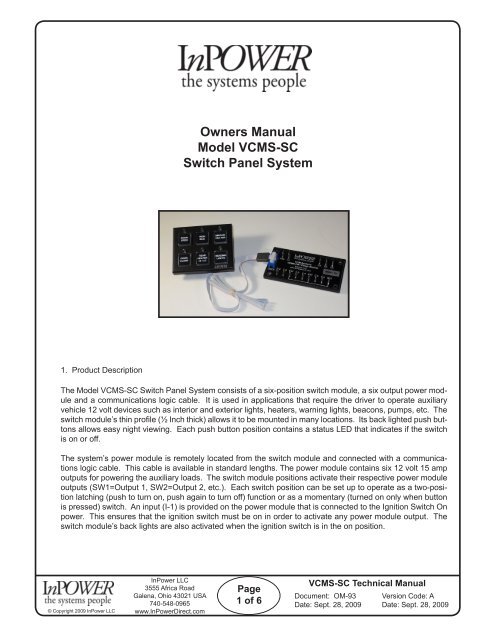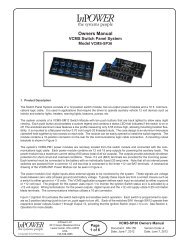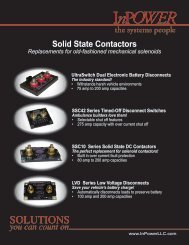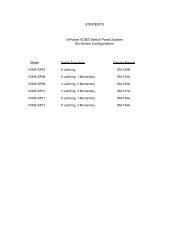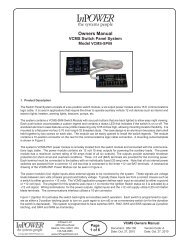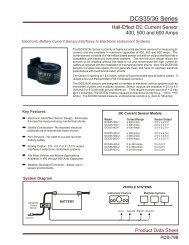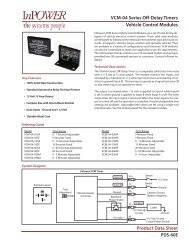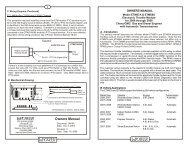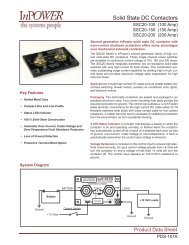Owners Manual Model VCMS-SC Switch Panel ... - InPower Direct
Owners Manual Model VCMS-SC Switch Panel ... - InPower Direct
Owners Manual Model VCMS-SC Switch Panel ... - InPower Direct
You also want an ePaper? Increase the reach of your titles
YUMPU automatically turns print PDFs into web optimized ePapers that Google loves.
<strong>Owners</strong> <strong>Manual</strong><br />
<strong>Model</strong> <strong>VCMS</strong>-<strong>SC</strong><br />
<strong>Switch</strong> <strong>Panel</strong> System<br />
1. Product Description<br />
The <strong>Model</strong> <strong>VCMS</strong>-<strong>SC</strong> <strong>Switch</strong> <strong>Panel</strong> System consists of a six-position switch module, a six output power module<br />
and a communications logic cable. It is used in applications that require the driver to operate auxiliary<br />
vehicle 12 volt devices such as interior and exterior lights, heaters, warning lights, beacons, pumps, etc. The<br />
switch module’s thin profile (½ Inch thick) allows it to be mounted in many locations. Its back lighted push buttons<br />
allows easy night viewing. Each push button position contains a status LED that indicates if the switch<br />
is on or off.<br />
The system’s power module is remotely located from the switch module and connected with a communications<br />
logic cable. This cable is available in standard lengths. The power module contains six 12 volt 15 amp<br />
outputs for powering the auxiliary loads. The switch module positions activate their respective power module<br />
outputs (SW1=Output 1, SW2=Output 2, etc.). Each switch position can be set up to operate as a two-position<br />
latching (push to turn on, push again to turn off) function or as a momentary (turned on only when button<br />
is pressed) switch. An input (I-1) is provided on the power module that is connected to the Ignition <strong>Switch</strong> On<br />
power. This ensures that the ignition switch must be on in order to activate any power module output. The<br />
switch module’s back lights are also activated when the ignition switch is in the on position.<br />
© Copyright 2009 <strong>InPower</strong> LLC<br />
<strong>InPower</strong> LLC<br />
3555 Africa Road<br />
Galena, Ohio 43021 USA<br />
740-548-0965<br />
www.<strong>InPower</strong><strong>Direct</strong>.com<br />
Page<br />
1 of 6<br />
<strong>VCMS</strong>-<strong>SC</strong> Technical <strong>Manual</strong><br />
Document: OM-93 Version Code: A<br />
Date: Sept. 28, 2009 Date: Sept. 28, 2009
<strong>VCMS</strong>-SM6<br />
<strong>Switch</strong> Module<br />
<strong>VCMS</strong>-<strong>SC</strong> <strong>Switch</strong> <strong>Panel</strong> System<br />
+12 Volts<br />
Ignition <strong>Switch</strong><br />
<strong>VCMS</strong>-PM1 Power Module<br />
Ground<br />
AUX. 1<br />
AUX. 3<br />
AUX. 5<br />
Logic Cable<br />
AUX. 2<br />
AUX. 4<br />
AUX. 6<br />
Aux. 1 Load<br />
Aux. 2 Load<br />
Fuse<br />
Outputs 15 Amps Max.<br />
15<br />
Fuse<br />
15<br />
Fuse<br />
15<br />
Aux. 3 Load<br />
Aux. 4 Load<br />
+12 V<br />
Battery<br />
Aux. 5 Load<br />
Aux. 6 Load<br />
2. <strong>Switch</strong> Module<br />
FIgure 1<br />
The system contains a <strong>Model</strong> <strong>VCMS</strong>-SM6 <strong>Switch</strong> Module containing six push buttons. The anodized<br />
aluminum case features a low profile measuring only 0.55 inches high. It is mounted to a flat panel via<br />
four 0.70 inch long 6-32 threaded studs. The case design is a two piece clam shell held together by two<br />
screws on each side. The module can be disassembled quickly for installing or changing switch legends<br />
by removing the four screws and separating the case. Each switch position contains a custom legend and<br />
status indicator and will be pre configured to be momentary or two-position latching. The module contains<br />
a 10-position connector on the rear for the communications logic cable connection. This connector accepts<br />
the communication logic cable that connects to the remote power module. The logic cable length is<br />
specified at time of order. Standard lengths are five, ten and twenty feet. A mounting cutout template is<br />
shown in Figure 3.<br />
6-Position <strong>Switch</strong> Module<br />
Logic Cable<br />
Connector<br />
2.74<br />
3.33<br />
Figure 2<br />
Not to scale.<br />
© Copyright 2009 <strong>InPower</strong> LLC<br />
<strong>InPower</strong> LLC<br />
3555 Africa Road<br />
Galena, Ohio 43021 USA<br />
740-548-0965<br />
www.<strong>InPower</strong><strong>Direct</strong>.com<br />
Page<br />
2 of 6<br />
<strong>VCMS</strong>-<strong>SC</strong> Technical <strong>Manual</strong><br />
Document: OM-96 Version Code: A<br />
Date: Sept. 21, 2009 Date: Sept. 21, 2009
6-Position <strong>Switch</strong> Module<br />
Mounting Cutout Detail<br />
Cutout for connector<br />
0.50<br />
0.25<br />
0.38<br />
0.95<br />
1.50<br />
2.74<br />
0.16 Diameter<br />
(For #6-32 screw)<br />
2.00<br />
3.33<br />
Not to scale.<br />
Figure 3<br />
3. Power Module - <strong>Model</strong> <strong>VCMS</strong>-PM1<br />
The <strong>Model</strong> <strong>VCMS</strong>-PM1 Power Module contains six 12 volt power outputs, four digital inputs and a communications<br />
interface. The six power outputs are set from commands received on the communications<br />
interface from the switch module. The status of the four digital inputs are continuously sent via the communications<br />
interface to the switch module where the application program resides. Wiring terminations<br />
for the power outputs, digital inputs and the +12 volt supply utilize 0.25 inch faston blade terminals. The<br />
communications interface utilizes a 10-pin connector. A power module diagram is shown in Figure 4.<br />
The power module’s six solid state outputs are high side drivers, each rated at +12 volts @ 15 amps.<br />
The outputs provide automatic shutdown protection for short circuit and overload conditions. Three +12<br />
volt terminals (BAT) are provided for the incoming battery power. Note that all six power switches are<br />
powered from a common 12 volt bus that is connected to the three +12 volt power terminals. To achieve<br />
the maximum power module current rating all three 12 volt power inputs must be connected to battery<br />
power through individually fused 15 amp feeds. A mechanical drawing of the <strong>VCMS</strong>-PM1 Power Module<br />
can be seen in Figure 5.<br />
The power module’s four digital Inputs allow external signals to be monitored by the system. These signals<br />
are voltage levels between zero volts (chassis ground) and battery voltage. Typically these inputs<br />
are from a contact closure such as a switch to either ground or +12 volts. The <strong>VCMS</strong> application program<br />
defines each input as actuated by either a ground or +12 volt input. The program for the <strong>VCMS</strong>-<strong>SC</strong> <strong>Switch</strong><br />
<strong>Panel</strong> System uses input I-1 to monitor the Ignition <strong>Switch</strong> status so it is activated by a +12 volt signal.<br />
© Copyright 2009 <strong>InPower</strong> LLC<br />
<strong>InPower</strong> LLC<br />
3555 Africa Road<br />
Galena, Ohio 43021 USA<br />
740-548-0965<br />
www.<strong>InPower</strong><strong>Direct</strong>.com<br />
Page<br />
3 of 6<br />
<strong>VCMS</strong>-<strong>SC</strong> Technical <strong>Manual</strong><br />
Document: OM-96 Version Code: A<br />
Date: Sept. 21, 2009 Date: Sept. 21, 2009
3. Power Module (Continued)<br />
Logic Cable<br />
<strong>VCMS</strong>-PM1 Power Module<br />
O-1<br />
12 Volt Load<br />
(Max. 15 Amps)<br />
+12 V<br />
Ignition <strong>Switch</strong><br />
+12V<br />
O-2<br />
BAT<br />
12 Volt Load<br />
(Max. 15 Amps)<br />
O-3<br />
12 Volt Load<br />
(Max. 15 Amps)<br />
+12V<br />
O-4<br />
BAT<br />
12 Volt Load<br />
(Max. 15 Amps)<br />
O-5<br />
12 Volt Load<br />
(Max. 15 Amps)<br />
Ground<br />
+12V<br />
O-6<br />
BAT<br />
12 Volt Load<br />
(Max. 15 Amps)<br />
Fuses<br />
15<br />
15<br />
15<br />
+12 Volt Battery<br />
Figure 4<br />
<strong>VCMS</strong>-PM1 Power Module<br />
Mod 1 R3<br />
Figure 5<br />
© Copyright 2009 <strong>InPower</strong> LLC<br />
<strong>InPower</strong> LLC<br />
3555 Africa Road<br />
Galena, Ohio 43021 USA<br />
740-548-0965<br />
www.<strong>InPower</strong><strong>Direct</strong>.com<br />
Page<br />
4 of 6<br />
<strong>VCMS</strong>-<strong>SC</strong> Technical <strong>Manual</strong><br />
Document: OM-96 Version Code: A<br />
Date: Sept. 21, 2009 Date: Sept. 21, 2009
4. Communications Logic Cable<br />
A communications function is required to pass information between the switch module and power module.<br />
A cable system is used to connect the communications interface circuit on the switch module with the one<br />
on the power module. A ribbon type cable is used with a connector at each end. The <strong>Model</strong> <strong>VCMS</strong>-<strong>SC</strong><br />
<strong>Switch</strong> <strong>Panel</strong> System uses a <strong>Model</strong> CA-<strong>VCMS</strong>-2 cable with the length of cable between the two connectors<br />
specified on the order.<br />
5. Wiring Terminations<br />
All power module wire connections utilize male 0.25 inch faston blade terminals. Wire connections to the<br />
power module should use insulated faston terminals, either straight or right angle type.<br />
6. Installation<br />
6.1 Getting Started<br />
Determine the best location for the switch module and the power module. Allow for the routing of the communications<br />
logic cable between the modules. We recommend installing the cable in a cable loom for protection.<br />
You will need a crimping tool for the 0.25 inch faston blade terminals. Be sure to follow the crimping<br />
tool instructions for the proper wire size and terminals.<br />
6.2 Mount the <strong>Switch</strong> Module<br />
Mount the switch module on a flat surface or mounting bracket using the four #6-32 threaded studs to secure<br />
the module to the panel. You will need to make a cutout for the logic cable connector (See Figure 3).<br />
Connect the logic cable to the switch module and route the cable to the power module.<br />
6.3 Mount the Power Module<br />
Mount the power module to a flat metal surface using four #6-32 screws. Do not over tighten the mounting<br />
screws and do not drill out these mounting holes to use larger screws. Next, connect the ground<br />
wire to the power module. Be sure to connect to a good quality vehicle ground source. It is important<br />
that the ground is connected to the power module before connecting the logic cable. Connect<br />
the power output wires and the input wires to the power module using insulated 0.25 inch faston terminals.<br />
After wiring the ground, power output and input wires connect the logic cable to the 10-position connector<br />
on the top of the module.<br />
Be sure to determine the current draw of the six power outputs to ensure that the power module is not overloaded.<br />
If inductive loads (motors, coils, etc.) are used it is important that these devices contain a diode<br />
suppressor across the device.<br />
Connect the three +12 volt power source wires to the three BAT terminals on the power module. These<br />
three wires must be fused at the power source. If the +12 volt power source is the vehicle battery, note<br />
that a <strong>VCMS</strong> configuration with a single power module with all switches and back lights off will draw about<br />
16 milliamps of power. Alternatively, you may obtain the +12 volts power from an ignition switch activated<br />
power source.<br />
© Copyright 2009 <strong>InPower</strong> LLC<br />
<strong>InPower</strong> LLC<br />
3555 Africa Road<br />
Galena, Ohio 43021 USA<br />
740-548-0965<br />
www.<strong>InPower</strong><strong>Direct</strong>.com<br />
Page<br />
5 of 6<br />
<strong>VCMS</strong>-<strong>SC</strong> Technical <strong>Manual</strong><br />
Document: OM-96 Version Code: A<br />
Date: Sept. 21, 2009 Date: Sept. 21, 2009
7. Operation<br />
Turn the Ignition <strong>Switch</strong> to the On position. The <strong>Switch</strong> Module’s back lights will illuminate.<br />
Operating any push button on the switch module will cause its status LED to turn on and the corresponding<br />
power module output to be activated. Activating switch position SW1 will cause power module output O-1<br />
to activate, SW2 will cause O-2 to activate, and so on.<br />
Note that if a switch position is activated and the Ignition <strong>Switch</strong> is turned off the power module output will<br />
turn off but the activated switch’s status LED will remain on, indicating that the switch is still activated.<br />
Each switch will function as a momentary or latching, depending on the system configuration specified at<br />
time of order. The following options are available:<br />
Option 1 - <strong>Switch</strong> 1 through 6 = Latching (2-Position)<br />
Option 2 - <strong>Switch</strong> 1 through 5 = Latching, <strong>Switch</strong> 6 = Momentary<br />
Option 3 - <strong>Switch</strong> 1 through 3 and <strong>Switch</strong> 5 = Latching, <strong>Switch</strong> 4 & 6 = Momentary<br />
Option 4 - <strong>Switch</strong> 1, 3 & 5 = Latching, <strong>Switch</strong> 2, 4 & 6 = Momentary<br />
<strong>Switch</strong> Module Positions<br />
SW 1<br />
SW 3<br />
SW 5<br />
SW 2<br />
SW 4<br />
SW 6<br />
© Copyright 2009 <strong>InPower</strong> LLC<br />
<strong>InPower</strong> LLC<br />
3555 Africa Road<br />
Galena, Ohio 43021 USA<br />
740-548-0965<br />
www.<strong>InPower</strong><strong>Direct</strong>.com<br />
Page<br />
6 of 6<br />
<strong>VCMS</strong>-<strong>SC</strong> Technical <strong>Manual</strong><br />
Document: OM-96 Version Code: A<br />
Date: Sept. 21, 2009 Date: Sept. 21, 2009


